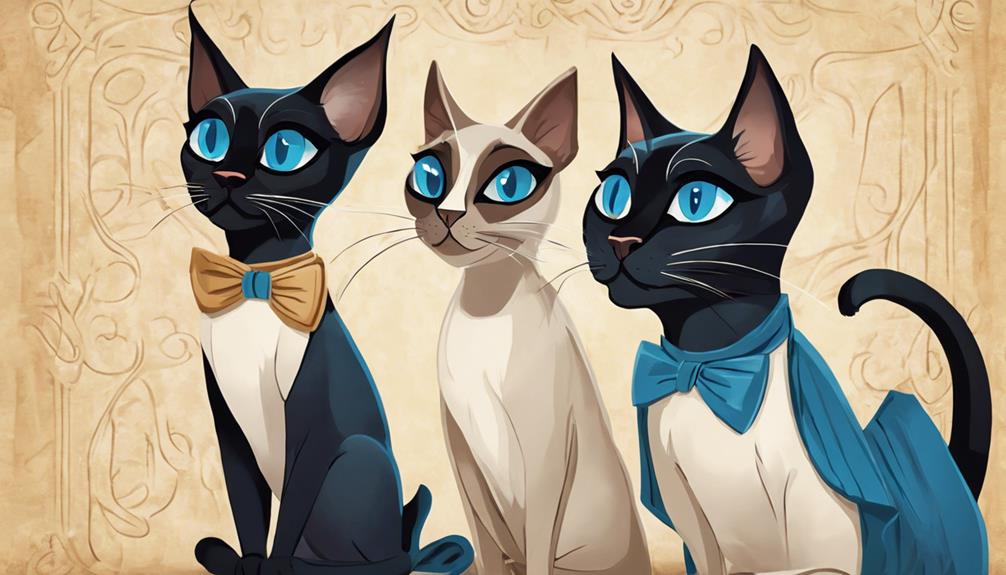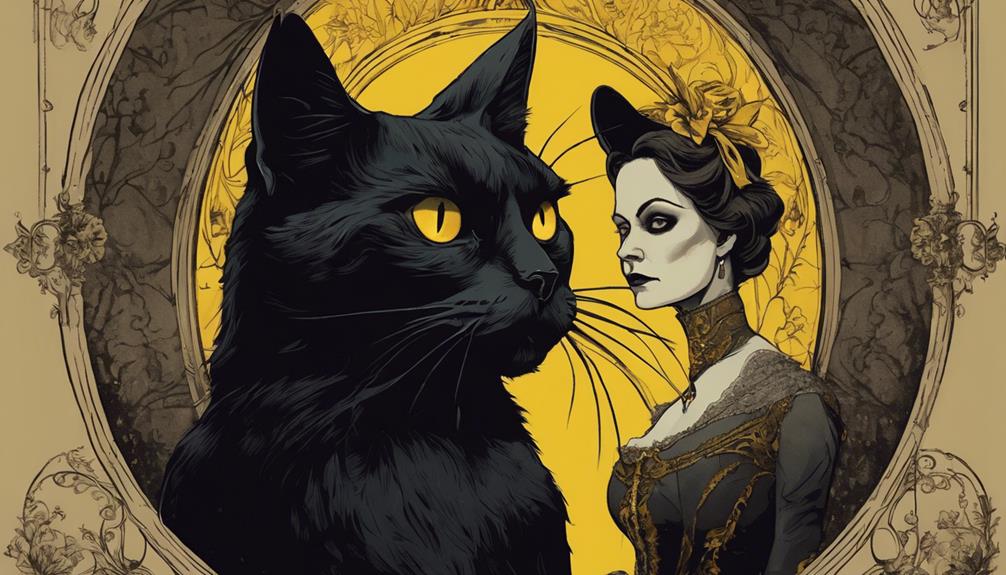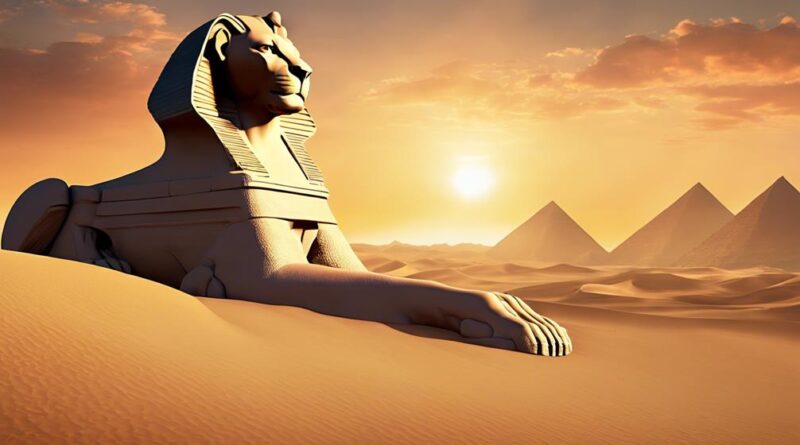9 Best Feline Depictions in Mythology and Literature
Exploring feline depictions in mythology and literature reveals captivating tales. Bastet, the Egyptian goddess, symbolizes protection and nurturing. Puss in Boots' cunning and wit teach valuable lessons. The Cheshire Cat intrigues with mystical wisdom. Freyja's divine cats embody independence and mysticism. Aslan, the majestic lion in Narnia, represents hope and strength. The Cat Sith from Scottish folklore enchants with magical abilities. Siamese cats in 'Lady and the Tramp' add intrigue and contrast. Japanese folklore worships the cat goddess for grace and fortune. Edgar Allan Poe's black cat symbolizes ominous guilt. Discover the rich symbolism and depth behind these feline characters.
Bastet in Ancient Egyptian Mythology
In Ancient Egyptian mythology, Bastet, often depicted as a lioness or a woman with the head of a lioness, was revered as a goddess of protection, fertility, and music. The significance of Bastet in Egyptian culture can't be overstated. She symbolized the nurturing and fierce aspects of a mother, protecting her children and ensuring fertility and abundance in the land. Bastet was also associated with music, specifically dance and the arts, representing a harmonious and joyful existence.
In modern interpretations and adaptations, Bastet has continued to captivate audiences worldwide. Her symbolism as a guardian and protector has been embraced by many who seek her guidance in times of need. Artists often depict her in various forms, blending traditional Egyptian iconography with contemporary styles to create a fusion of ancient mystique and modern appeal. Furthermore, Bastet's representation as a strong, independent female figure has resonated with feminist movements, celebrating her power and grace.
Bastet's legacy endures through the ages, inspiring creativity and reverence. Her multifaceted nature as a deity of protection, fertility, and music continues to fascinate scholars and enthusiasts alike, underscoring the timeless allure of this feline goddess in both ancient mythologies and contemporary adaptations.
Puss in Boots in Fairy Tales
With an intriguing blend of cunning and charm, 'Puss in Boots' emerges as a notable character in the realm of fairy tales, captivating readers with his clever exploits and quick wit. This charismatic feline is often depicted as a master manipulator, using his intelligence to outsmart others for the benefit of his master. Character analysis reveals Puss as not just an ordinary cat but a sophisticated and strategic thinker, always plotting his next move to secure a better future for himself and his owner.
One of the key moral lessons that 'Puss in Boots' imparts is the importance of wit and resourcefulness over brute strength. Through his actions and schemes, he teaches readers that intelligence and cleverness can often triumph over sheer power. This message resonates with audiences, showcasing the value of quick thinking and cunning strategies in overcoming obstacles.
Furthermore, 'Puss in Boots' also highlights the significance of loyalty and devotion. Despite his crafty nature, he remains steadfast in his commitment to his master, working tirelessly to improve their situation. This aspect of his character adds depth to the story, underscoring the importance of loyalty and dedication in relationships.
The Cheshire Cat in Alice's Adventures
The enigmatic presence of the Cheshire Cat in Alice's Adventures captivates readers with its cryptic wisdom and mischievous charm, weaving a thread of intrigue throughout the narrative. The Cheshire Cat, known for its distinctive enigmatic smile, serves as a central figure in Wonderland, offering Alice guidance through its perplexing riddles and paradoxical statements.
The Cheshire Cat's mischievous antics play a crucial role in challenging Alice's perceptions of reality and logic. By appearing and disappearing at will, leaving only its grin behind, the cat symbolizes the whimsical and unpredictable nature of Wonderland. Its ability to control its visibility adds to the sense of mystery surrounding its character, leaving both Alice and readers questioning the true intentions behind its actions.
Moreover, the enigmatic smile of the Cheshire Cat represents a deeper layer of complexity within its persona. Beyond its playful exterior, the cat embodies a sense of philosophical depth, often providing Alice with thought-provoking insights that blur the line between sense and nonsense. The cat's presence highlights the absurdity of Wonderland while simultaneously guiding Alice through her journey of self-discovery.
Freyja's Cats in Norse Mythology
The enigmatic allure of feline beings extends beyond the realms of Wonderland into Norse mythology, where the cats belonging to Freyja, the goddess of love, fertility, and magic, hold a significant position intertwined with ancient beliefs and symbolism. Freyja's companions, these magical cats, known as 'skogkatter' or forest cats, are believed to pull her chariot, a symbol of her connection to both earthly and mystical realms. These cats aren't ordinary felines; they're considered divine and mystical beings that aid Freyja in her journeys between worlds.
In Norse mythology, cats are often associated with femininity, independence, and mysticism, all qualities that embody Freyja as a goddess. The magical cats of Freyja are revered for their grace, agility, and mysterious nature, reflecting the characteristics of the goddess herself. They're thought to possess the ability to see in the dark, a trait that aligns with Freyja's role as a seeress and wielder of magic.
The bond between Freyja and her magical cats symbolizes a deep connection between the goddess and the animal world, highlighting the importance of nature and its mystical inhabitants in Norse mythology. As symbols of fertility, love, and magic, Freyja's cats represent the harmonious balance between the divine and the natural world, embodying the essence of the goddess they accompany.
The Lion in The Chronicles of Narnia
Amidst the enchanting world of C.S. Lewis's Chronicles of Narnia, a majestic and powerful presence looms in the form of Aslan, the revered lion figure central to the series' narrative and symbolism. As you delve into the world of Narnia through the pages of these beloved books, you witness the depth and complexity that Aslan brings to the story.
- Lion symbolism, allegorical connections: Aslan embodies various allegorical connections, representing themes such as sacrifice, redemption, and ultimate good. His character serves as a symbol of courage and righteousness.
- Aslan's role in shaping characters: Through his interactions with the protagonists, Aslan influences their growth and development. His guidance and wisdom help shape the choices and actions of characters like Lucy, Peter, Susan, and Edmund.
- Impact on the storyline: Aslan's presence drives the overarching narrative of the series. His interventions and decisions often steer the course of events, leading to pivotal moments that shape the destiny of Narnia.
- Character development: Aslan's own character undergoes development throughout the series. From his mysterious introduction to his sacrificial act and eventual return, his evolution mirrors the growth of the world he oversees.
- Symbolic significance: The lion Aslan isn't just a character; he's a symbol of hope, strength, and the enduring fight against darkness. His symbolic significance resonates with readers long after the final pages are turned.
The Cat Sith in Scottish Folklore
Engage with the mystical realm of Scottish folklore by exploring the enigmatic presence of the Cat Sith. In Scottish lore, the Cat Sith is portrayed as an otherworldly creature that roams the Highlands. Superstitions surrounding this feline being are deeply rooted in the rich tapestry of Scottish culture.
The Cat Sith is often described as a large black cat with a white spot on its chest, a feature that sets it apart from ordinary felines. According to legend, this spectral creature has the ability to steal the soul of the deceased before the gods can claim it, leading to the tradition of keeping a watchful eye over the deceased until they're buried to prevent the Cat Sith from snatching their soul.
In Scottish folklore, it's believed that the Cat Sith has the power to bring both blessings and curses. Some view it as a guardian spirit, while others fear its presence as an omen of misfortune. The Cat Sith is said to possess magical abilities, including shape-shifting into various forms and casting spells on unsuspecting victims.
The Siamese Cats in Lady and the Tramp

Portrayed as mischievous and cunning, the Siamese cats in 'Lady and the Tramp' exhibit a blend of elegance and deceit that adds depth to the storyline. These cats bring a unique dynamic to the movie through their Siamese charm and animated antics. Here are some key aspects that make the Siamese cats stand out:
- Distinct Appearance: The Siamese cats are visually striking with their blue almond-shaped eyes and sleek, cream-colored fur with dark markings. This distinctive appearance sets them apart from the other characters in the movie.
- Musical Prowess: The Siamese cats showcase their feline love for mischief through their memorable musical number, 'We are Siamese if you please'. Their harmonized voices and synchronized movements add a touch of whimsy to the film.
- Contrast to Lady and Tramp: In contrast to Lady and Tramp's spaghetti romance, the Siamese cats represent a darker side of pet behavior. Their scheming nature and attempts to frame Lady create tension and conflict in the storyline.
- Symbolism of Deceit: The Siamese cats serve as symbols of deceit and manipulation, adding a layer of complexity to the narrative. Their actions drive the plot forward and highlight the darker aspects of pet behavior.
- Comic Relief: Despite their villainous roles, the Siamese cats provide comic relief through their exaggerated expressions and over-the-top antics, balancing out the more serious themes of the movie.
The Cat Goddess in Japanese Folklore
The Cat Goddess in Japanese Folklore embodies a revered presence, intertwining mystique and power within the tapestry of ancient tales and beliefs. Known as Bastet in Egyptian mythology but revered in a unique Japanese context, this feline deity represents a blend of grace, mystery, and magic in folklore. Cats were believed to be the earthly form of this goddess, revered for their grace and agility. In Japanese folklore, cats are often depicted as protectors, bringing good fortune to those who show them kindness.
Purrs and magic are intertwined in the stories surrounding the Cat Goddess. Legend has it that cats possess the ability to bring luck and ward off evil spirits. Their purrs are said to have healing powers, soothing ailments and bringing comfort to those in need. This association with healing and protection further solidifies the Cat Goddess's revered status in Japanese culture.
Mysterious transformations are also a common theme in Japanese folklore involving cats. Stories depict cats transforming into humans or other creatures, blurring the lines between reality and fantasy. These tales highlight the mystical nature of the Cat Goddess and her feline counterparts, adding an element of enchantment to Japanese mythology. The Cat Goddess in Japanese Folklore continues to captivate imaginations, symbolizing the enduring allure of these enigmatic creatures in ancient beliefs.
The Black Cat in Edgar Allan Poe's Works

In Edgar Allan Poe's works, a shadowy figure lurks, embodying darkness and foreboding – the Black Cat. This eerie creature symbolizes various themes and holds significant superstitions attached to its presence in Poe's narratives.
- Symbolism: The black cat in Poe's works is often seen as a symbol of impending doom or a manifestation of the protagonist's guilt and inner demons.
- Superstition: Black cats have long been associated with bad luck and witchcraft in folklore, adding a layer of mystery and fear to Poe's tales.
- Psychological Depth: Poe delves into the psychological aspects of superstitions surrounding black cats, exploring how fear and guilt can consume a person's mind.
- Foreshadowing: The appearance of the black cat in Poe's stories serves as a foreshadowing element, hinting at tragic events to come and building suspense.
- Morality: Through the black cat, Poe explores themes of morality and conscience, questioning the consequences of one's actions and the price of sin.
Poe masterfully weaves the symbolism and superstitions surrounding black cats into his narratives, creating a sense of unease and mystery that captivates readers. The black cat stands as a powerful literary device, embodying darkness and evoking primal fears, making it a timeless and iconic element in Poe's works.
Frequently Asked Questions
How Were Bastet's Depictions Influenced by Other Egyptian Deities?
When exploring Bastet's depictions and Egyptian influence, it's evident that her origins are intricately linked to other deities. Bastet's portrayal as a lioness-headed or cat-headed goddess showcases a fusion of characteristics from goddesses like Sekhmet and Mafdet.
Sekhmet's fierce warrior traits and Mafdet's association with protection and justice likely influenced Bastet's roles as a guardian deity and defender against evil forces in Egyptian mythology.
What Cultural Significance Do Freyja's Cats Hold in Norse Mythology?
In Norse mythology, Freyja's cats hold significant cultural symbolism. They're known to represent independence, cunning, and magic. These feline companions are believed to have served as protectors and companions for the goddess, enhancing her mystical aura and embodying her fierce and determined nature.
Through their mythological significance, Freyja's cats reflect the deep connection between animals and deities in Norse culture, showcasing the intertwined relationship between humans, gods, and nature.
Why Does the Cheshire Cat Often Disappear in Alice's Adventures?
The Cheshire Cat often disappears in Alice's Adventures for various reasons. Its vanishing act symbolizes the transient and ever-changing nature of Wonderland.
This curious behavior highlights the cat's mysterious nature, adding to the whimsical and unpredictable atmosphere of the story.
Are There Any Real-Life Inspirations for Puss in Boots?
Real life inspirations for Puss in Boots can be found in various aspects of cat fashion, feline behavior, and historical connections. Cats have long been associated with cunning and cleverness, traits that are mirrored in Puss in Boots' character.
The idea of a cat wearing boots and embarking on adventures likely stems from the combination of cats' agility and the historical association of boots with travel and exploration.
What Symbolism Does the Black Cat Represent in Poe's Works?
In Edgar Allan Poe's works, the black cat symbolizes various dark and ominous themes. Poe often used symbolism to convey deeper meanings in his Gothic literature, and the black cat is no exception.
The feline imagery represents mystery, superstition, and even death in Poe's narratives. By incorporating the black cat as a symbol, Poe adds layers of complexity to his stories, creating a sense of foreboding and unease for the reader.
Conclusion
In conclusion, felines have played significant roles in mythology and literature, representing various traits such as cunning, wisdom, and mystery. From the revered Bastet in Ancient Egypt to the mischievous Cheshire Cat in Alice's Adventures, these depictions showcase the diverse and enduring appeal of cats in storytelling.
Their presence adds depth and intrigue to the narratives they inhabit, making them beloved and iconic characters in the world of myths and literature.
